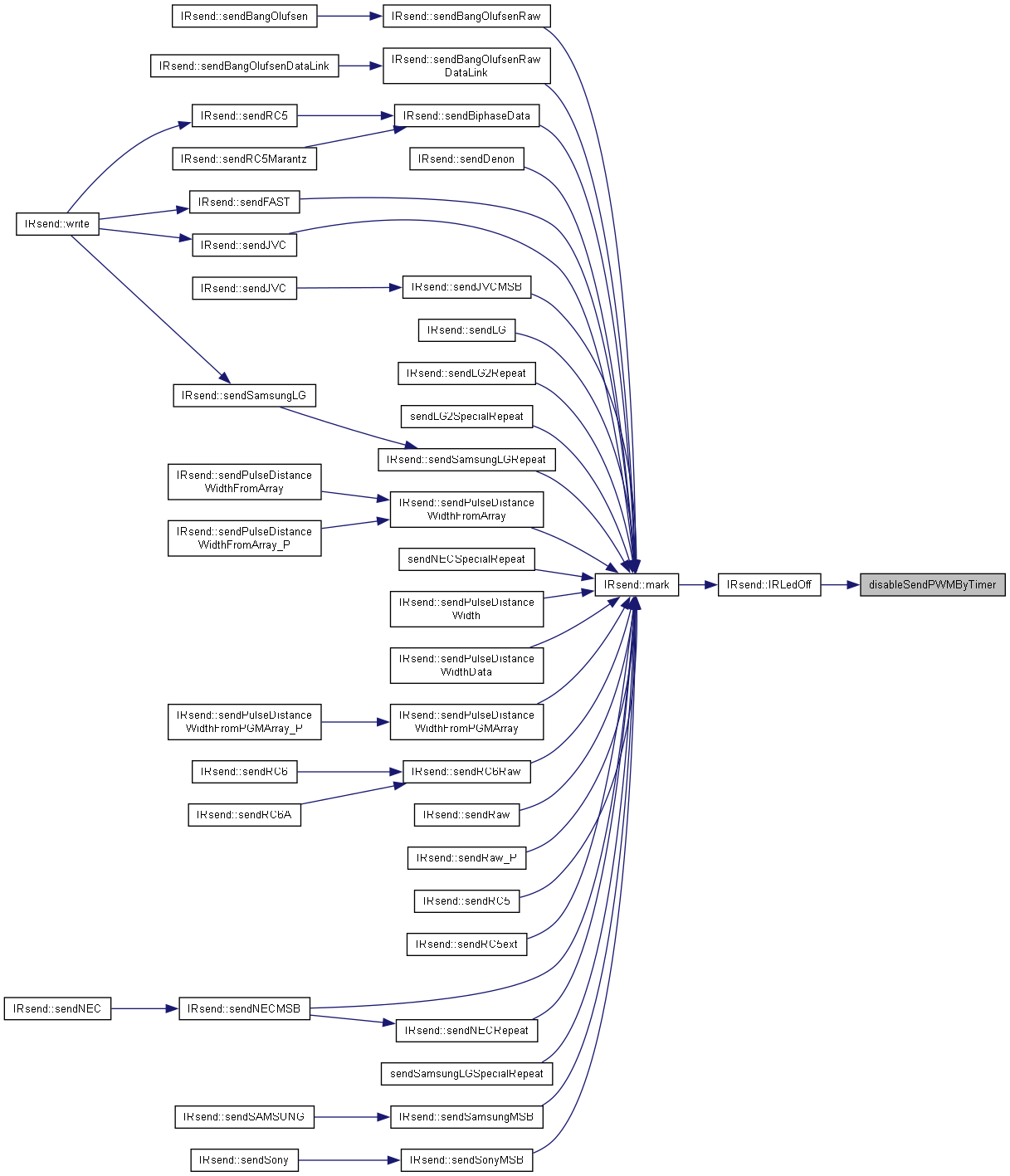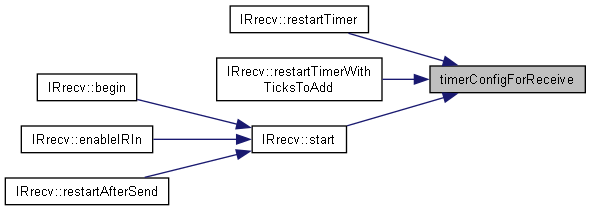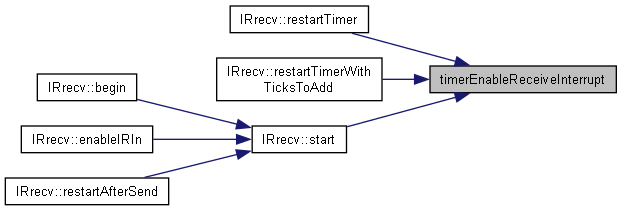
Macros | |
| #define | IR_SEND_DUTY_CYCLE_PERCENT_FOR_LEVEL_HIGH IR_SEND_DUTY_CYCLE_PERCENT |
| #define | IR_SEND_PIN |
| Hardware / timer dependent pin number for sending IR if SEND_PWM_BY_TIMER is defined. More... | |
Functions | |
| void | timerConfigForReceive () |
| Configures the timer to be able to generate the receive sample interrupt, which consumes a small amount of CPU every 50 (MICROS_PER_TICK) us. More... | |
| void | timerEnableReceiveInterrupt () |
| Enables the receive sample timer interrupt, which consumes a small amount of CPU every 50 us. More... | |
| void | timerDisableReceiveInterrupt () |
| Disables the receive sample timer interrupt. More... | |
| void | timerResetInterruptPending () |
| void | timerConfigForSend (uint16_t aFrequencyKHz) |
| IF PWM should be generated not by software, but by a timer, this function sets output pin mode, configures the timer for generating a PWM with HIGH output level of duty cycle of IR_SEND_DUTY_CYCLE_PERCENT_FOR_LEVEL_HIGH and disables the receive interrupt if it uses the same resource. More... | |
| void | enableSendPWMByTimer () |
| Enables output of the PWM signal of the timer at the timer pin. More... | |
| void | disableSendPWMByTimer () |
| Disables output of the PWM signal of the timer at the timer pin and set it to inactive. More... | |
Detailed Description
Macro Definition Documentation
◆ IR_SEND_DUTY_CYCLE_PERCENT_FOR_LEVEL_HIGH
| #define IR_SEND_DUTY_CYCLE_PERCENT_FOR_LEVEL_HIGH IR_SEND_DUTY_CYCLE_PERCENT |
Definition at line 71 of file IRTimer.hpp.
◆ IR_SEND_PIN
| #define IR_SEND_PIN |
Hardware / timer dependent pin number for sending IR if SEND_PWM_BY_TIMER is defined.
Otherwise used as default for IrSender.sendPin.
Definition at line 105 of file IRTimer.hpp.
Function Documentation
◆ disableSendPWMByTimer()
| void disableSendPWMByTimer | ( | ) |
Disables output of the PWM signal of the timer at the timer pin and set it to inactive.
Definition at line 147 of file IRTimer.hpp.

◆ enableSendPWMByTimer()
| void enableSendPWMByTimer | ( | ) |
Enables output of the PWM signal of the timer at the timer pin.
Definition at line 142 of file IRTimer.hpp.

◆ timerConfigForReceive()
| void timerConfigForReceive | ( | ) |
Configures the timer to be able to generate the receive sample interrupt, which consumes a small amount of CPU every 50 (MICROS_PER_TICK) us.
The actual interrupt generation is controlled by timerEnableReceiveInterrupt() and timerDisableReceiveInterrupt(). timerConfigForReceive() is used exclusively by IRrecv::start()
Definition at line 112 of file IRTimer.hpp.

◆ timerConfigForSend()
| void timerConfigForSend | ( | uint16_t | aFrequencyKHz | ) |
IF PWM should be generated not by software, but by a timer, this function sets output pin mode, configures the timer for generating a PWM with HIGH output level of duty cycle of IR_SEND_DUTY_CYCLE_PERCENT_FOR_LEVEL_HIGH and disables the receive interrupt if it uses the same resource.
For most architectures, the pin number(s) which can be used for output is determined by the timer used! The output of the PWM signal is controlled by enableSendPWMByTimer() and disableSendPWMByTimer(). timerConfigForSend() is used exclusively by IRsend::enableIROut().
- Parameters
-
aFrequencyKHz Frequency of the sent PWM signal in kHz. There is no practical reason to have a sub kHz resolution for sending frequency :-).
Definition at line 136 of file IRTimer.hpp.

◆ timerDisableReceiveInterrupt()
| void timerDisableReceiveInterrupt | ( | ) |
Disables the receive sample timer interrupt.
This must be done before using the timer for e.g. tone(). Is a synonym for calling end() or stop().
Definition at line 124 of file IRTimer.hpp.

◆ timerEnableReceiveInterrupt()
| void timerEnableReceiveInterrupt | ( | ) |
Enables the receive sample timer interrupt, which consumes a small amount of CPU every 50 us.
Definition at line 117 of file IRTimer.hpp.

◆ timerResetInterruptPending()
| void timerResetInterruptPending | ( | ) |

